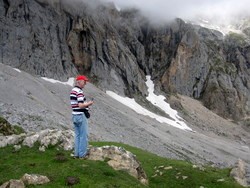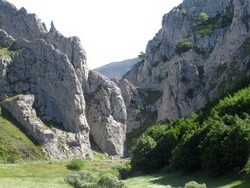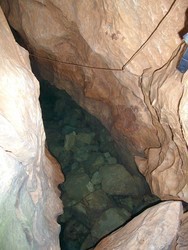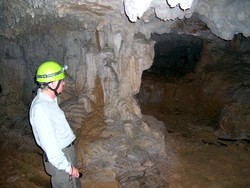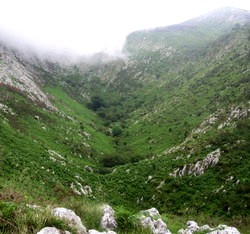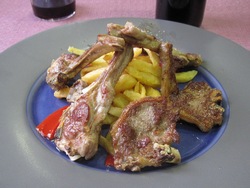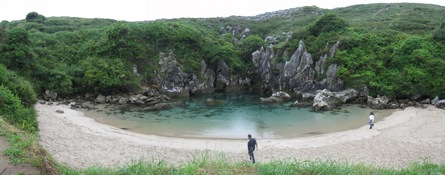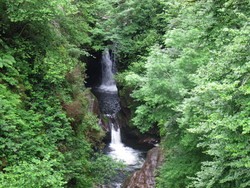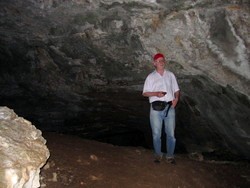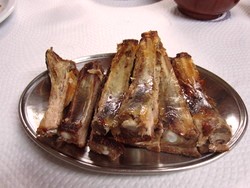

Introduction
Site list (GPS fixes) Walks (GPS tracks) Video clips Panoramas
Electronic projects:
Bat detector
Lamp tests
µ-controlled lamp
SEPIC-based lamp
ISP isolators
Making SMT boards
Expedition logs:
Spain 1973, 1974,
1975, 1976, 1977,
1979, 1982, 1983,
1985, 1986, 1987,
1988, 1989, 2000,
2001, 2002, 2003,
2004, 2005, 2006,
2007, 2008, 2009,
2010, 2011, 2012,
2013, 2014, 2015,
2016, 2017, 2018,
2019, 2020, 2021,
2022, 2023
Mexico
New England
Translation:
Expedition log, Summer 2012
Potes, Nansa & Saja valleys, Gulpiyuri, Andara mines.
| Date | Activity |
|---|---|
| 12.06 | Tuesday; Bill’s plane was an hour late from Pisa, but he still arrived in Santander well before Mike. First stop Puente Arce – but La Puentecilla was closed. On to Potes, with stops at San Vicente for tortilla and La Hermida for Peña Prieta. Explored the town and river walk before dinner at El Che (including the biggest chuletilla known to ‘lamb’). |
| 13.06 |
Good weather so the High Picos beckoned. Tried a new track up from
Mogrovejo which was ‘adventurous’ – steep, gravelly, and wet in
places – and at the limit of what the car could do. Eventually
made it to a more level stretch alongside a vega which led to a muddy
stretch and a narrow gate before joining the main Espinama–Sotres
track.
From there we drove to Refugio de Áliva, parked the car, and had a pleasant walk to a small peak overlooking the blenda (zinc) mines. Back to the car and down to Espinama for lunch at Rte. Maximo. Back to Potes and to Rte. Majada for dinner (paella & merluza a la Romana). |
| 14.06 | Headed SE from Potes along a road new to Speleogroup, to Puerto de Piedrasluengas (1,355 m). Found a nice little limestone gorge just south of the pass, but not much else. Very windy, but a good view of the Picos from the Mirador at the pass. Then north to join the headwaters of the Nansa and past the quite spectacular Embalse de Cohilla dam – unfortunately no limestone to be seen. Continued following the Nansa to Puentenansa then East to La Fuente and the Deva gorge to complete a round trip to Potes. Explored more of the town and river walk in the afternoon. Dinner at El Cenador del Capitán, overlooking the river and town. Excellent chuletillas, this time; mushroom omelette and Cabrales for Bill. |
| 15.06 |
Checked out of the hotel and headed south to the vauclusian rising
south of Estragüeña and changed into plastic sandals to ford
the river. Mike wimped out due to the cold and depth of the water
and retreated to make a GPS fix (📌),
but Bill persevered with moral support from the road above.
It took 15 minutes or more to cross to the west bank of the Deva due to the deep water, strong current and slippery rocks! The cave entrance is a short vadose passage leading immediately to a deep sump pool (visited by Bill and Mike Weeks during the BUSS 1973 expedition). Since then, someone has set up a diving line into the deep sump pool (several metres deep). Having failed to get out of sight of daylight, some photos were taken. It took less than 5 minutes to wade back and reach the road by a climb. One cave successfully explored; on to La Borbolla. Unable to find the cave there we consoled ourselves with a light lunch at Casa Poli. Checked into hotel in Llanes then decided that Bolado cave would be an excellent place to test new 3W LED lights and surveying reflectors. All worked well (new white reflector tape better than red). Back to Llanes via Playa de Andrín and Cue. |
| 16.06 | After three days of perfect weather came a very wet day; so much so we were wishing we were back south in Potes in the rain shadow. Making the most of a bad day we drove south to La Robellada and then to Mestas de Con (for quick refreshment in Casa María) and on. Recce’d possible road to Cueva Huelga (towards Torío) but it was still wet. So back north again via Cangas and Arriondas to Ribadesella for lunch (half menu – € 7) at El Mesón Miño . Good food but awful wine which we mostly left. Then a glass of decent Rioja in El Escondito (under new management). Dinner in Llanes at El Almecen sidrería with pimiento rellenos de boletus for Bill and costillinas (ribs) for Mike. |
| 17.06 | Rained overnight but a dry day with grey clouds over the Sierra de
Cuera. Destination above Alto de la Tornería, where we parked
the car, and a difficult walk (gpx)
to the two big depressions 2km to the east (the first being La Raíz).
The paths were muddy from the previous day’s rain and gorse and barbed
wire seemed sharper than usual. But the low cloud and mist (and
wet vegetation) actually made the walk pleasantly cooler than it
might have been. But there were worries (unfounded) that the mist
would come down further and make navigation difficult.
In the first depression Mike found the small stream sinking in an impenetrable crack. In contact by radio Bill proceeded above and north to a saddle where there was a real pothole with vertical sides, perhaps 12m deep. Impossible to tell whether it “goes”. We reunited, after climbing very rough terrain, even higher on the ridge guarding the next big depression (east) which seemed to have no surface water and multiple sink points (so not interesting). The return was predictably strenuous, with a very steep ascent out of the main depression, spiced with more barbed wire and edgy moving handholds. Some last-minute contouring saved a useful descent and ascent and resulted in a perfectly timed 3.4 hours walk that brought us to El Mazuco at 14:00 for lunch of criollo, filete de ternera, and patatas ali-oli at El Roxin. Back via Posada to Llanes. Dinner at Casa Canene; fish soup, entremeses, merluza. |
| 18.06 | Light rain, so headed South (inland) to La Molina (near Ortiguero) to view the lie of the land for locating the resurgence of Cueva Dobros. After finding a promising track for a drier day, backtracked though the village and walked up to Puente Pompedro which crosses the river (Río Casaño) above a fine white-water canyon. Next to Poncebos and up many hairpins to Camarmeña for a view of the Bulnes gorge. Lunch in Arenas at Sidrería Calluenga: pimientos rellenos con carnes a la Cabrales and very good chuletillas. Cards in the afternoon (first time since the 80s!). Dinner at Sidrería El Pescador: lacon con pimientos and gambas al ajillo (the latter excellent gambas but the sauce not as good as last year – now a copy of Casa Poli’s?). |
| 19.06 | More rain; spent the morning in the hotel updating the log, etc. Sprinted across the road to La Terraza for a tabla de queso for lunch (Peñamuellera and Vidiago best of the ‘white’ cheeses). Soon after, the rain more-or-less stopped and we headed west to Naves to find Playa de Gulpiyuri – an inland beach (📌) connected to the sea by caves. Fascinating. Back to Llanes via Ribadesella and Posada; dinner at Sidrería Salero. |
| 20.06 | Light rain, and forecast for the rest for the day, too, so time to
head south. Decided on the route South from Cabezón de la Sal
(along the river Saja) which we had not traversed before and which
crosses at least a few bands of (Jurassic) limestone.
First stop Ruente to admire the water in the river from the Fuentona. Then onwards south to the Interpretation Centre for the Parque Natural Saya-Besaja at Puente de Cueva Pollo. An expensive building with nice photographs and a few artifacts (including an unusual Roman oil lamp) but very few hard facts, and no Cueva Pollo exists either – so we pressed on South through the Park.Pleasing scenery and finally sight of limestone on the way up to Puerto de Palombera; an obvious sink by the road (📌), just North of the pass (at Venta de Tajahierro) was investigated but was choked with sand and gravel. Next stop was the Source of the River Ebro; a mucky park but an impressive resurgence (Fuentonas). Lunch in Reinosa (remarkably restaurant-free) at Mesón las Fuentes; good and abundant jamon (which Bill ate with his fingers) and adequate lomo, but Mike foolishly chose chuletillas de cordero (instead of de lechazo) which were the worst in memory – more gristle than meat, and tasteless. Back North on the new Autovía, then stopped to investigate two large depressions NE of Cabezón. The first, at Bustablado, had a very promising stream and cliff face (📌) but no cave. The second, a little NW, was huge and had a track down it but no obvious sinks; we beat a hasty retreat when a herd of cattle started up the path and threatened to trap the car for hours. Returning up the track was ‘interesting’ but fine driving by Bill got us up around the steep and gravelly crux corner. Back to Llanes via Comillas and San Vicente; dinner in the Sidrería in the main square. |
| 21.06 | A windy night had not swept away the grey clouds, but at least it wasn’t raining. Off to locate Cueva Huelga surveyed by the British Speleological Expedition of 1965 (and resurveyed by OUCC in 1976). The location of the two entrances was not very clear and the old Lambert grid references were wrong by some 350m. Worse still, the location of cave has been deliberately mispositioned on at least one website.
The approach road is the first on the right, 100m south from the roundabout on the Cangas to Mestas de Con road at the junction with the road to Covadonga. Proceed along a winding road without entering the hamlet of Cabielles and turn left up a track leading South past a chapel (Ermíta de San Cosme); the cave is 600m SSE of the chapel. The Arroyo de la Huelga enters the cave at the foot of a wooded 15m cliff face about 40m east of the track (📌). When we visited, the stream was dry. A through trip is possible. We proceeded back via the village of Torío passing some minor depressions and then south up the Lakes road to Cueva Trumbio. Here the countryside was much more overgrown than in previous years. In particular the thick gorse and steep valley sides prevented us from actually getting into the cave itself! Disappointing. :-( The mountains were cloudy and a thick mist was coming down fast. Lunch at the Bar María Rosa: truchas stuffed with bacon (the best since the 1980s) & chips. No sign of the old Refugio. Then back down through the mist to Llanes. Asturian paella, and lomo, at Rte. Uría. |
| 22.06 | Promising weather, so first to La Molina (Ortiguero) to look for the
resurgence of Cueva Dobros. The steep track spotted on the 18th
soon became ruts in a meadow then petered out. After a small stream
and another meadow and woods we were forced down to the river by
a precipitous limestone outcrop; the ‘jungle’ there proved inpenetrable.
There had been sun on the way down, but fortunately it clouded over for the long sticky ascent back up the hillside. A beer at Carreña de Cabrales was most welcome. On to a chilly Sotres to research lunch possibilities; none appealed. Stopped in Tielve, but no food. However, a 200m backtrack up the ‘main’ road from the Tielve turnoff brought us to a Hotel-Restaurant spotted by Bill: El Duje. Here the cheerful and pleasant landlady treated us to a fixed menú del día of very good fabada and lomo along with an amuse-bouche of excellent home-made Cabrales cheese. Along with the usual bread & wine, all for €10, this was the best menú of the trip and possibly for years. The landlady’s very young son shyly bade us farewell in a few words of English, and we returned to Casa Ramón in Careña for more cheese (azul de tres leches) before looking for another approach to the Dubros resurgence (deemed infeasible). A very light dinner (a shared plate of fritos de pixin) sufficed. |
| 23.06 |
Sun to start the day, so off to Villa and Rotella to look for caves
last visited by Bill and OUCC in 1973. Six depressions on the map;
two known caves. The first depression visited (📌) was a blank; the second, deepest, depression yielded
a cave with a 10m-high entrance that led to further passage (📌). Hot and difficult walking (gpx),
so the remaining depressions were left for another year.
Refreshed by a beer at El Sucón, next stop was the resurgence at Caldueñín for GPS (📌) and photographs; water level was low. We then explored the upper series above the entrance pathway and even managed to get out of sight of daylight. Continuing up the hill, we explored a (very muddy) track that might have led to a fossil resurgence above Caldueñín; none found, and a ‘possible cheese cave’ turned out to be a tomb/shrine. All this caving activity had nicely filled the morning and we arrived at El Mazuco at lunchtime (14:00) – criollo, patatas ali oli, and excellent (tasty & tender) costillas de cerdo (ribs) at Rte. El Roxin.
|
| 24.06 | A pure-blue-sky day with 21°C forecast; ideal for the higher Picos. Off to Sotres with a couple of walks in mind: North(ish) to the Majada de Tordín above Tielve or South(ish) to the mines of Andara. The track to the former, shown on both maps we have, simply does not exist, so South we went. A steady ascent of more than 400m in 4km up the rocky track gained us some spectacular views of the Picos and the Sierra de Cuera. At the mines, the Refugio Casetón de Andara was manned and we were able to sip a welcome cold beer while admiring the fabulous view. Back down the way we came, investigating a mine and some small caves on the way. 3 hours in all (gpx). Tabla de quesos y embutidos in Sotres (overpriced as expected). Back to Llanes via Arenas, Posada, and Andrín. Dinner at Casa Canene (merluza a la plancha) – a reminder not to eat fish on Sunday. |
| 25.06 | Another sunny day. Casa Gloria at Camijanes was closed so no roast lamb for lunch. Walked over the fields to depressions (📌) near Canto Grande north west of Cabanzón but the multiple sinks seemed unpromising and gorse prevented close inspection. Failed to find Bill’s decorated cave (explored with John Forder in 1974) west of Merodio. But we did find Cueva la Loja close to river level (📌) near El Mazu. Good lunch at Las Brasas, San Vicente (pimientos rellenos de carne, lubina a la plancha for Bill, sopa de pescado and chuletillas de lechazo for Mike, all washed down with a bottle of Albariño). Back to Llanes to pack, etc. Dinner at La Amistad, and a late night. |
| 26.06 | To Santander airport via Comillas. Flights on time and uneventful journeys home. |
Personnel: Bill Collis & Mike Cowlishaw.
Notes:
- Exchange rate: 1.24; 81p = 1 Euro = 166 pesetas (205 pts/GBP).
- Weather: four wet days and some cloudy ones.
- Specific GPS positions are shown by a pushpin symbol (📌) in the log above – click on the symbol for a Google maps view of the fix. These positions are also listed on the Speleogroup site list page with coordinates in °,′,″ degrees using WGS84 datum and in UTM coordinates; see Coordinate systems.
- Some walks were recorded as GPS tracks; the .gpx files are linked above and can also be found on the Speleogroup tracks page; tracks and fixes were recorded using a Garmin eTrex Vista HCx.
- This log was almost entirely edited in the field on an ASUS Eee PC 900, using the MemoWiki » extended Wiki notation which is then processed by a Rexx » script to generate the HTML for this web page.
